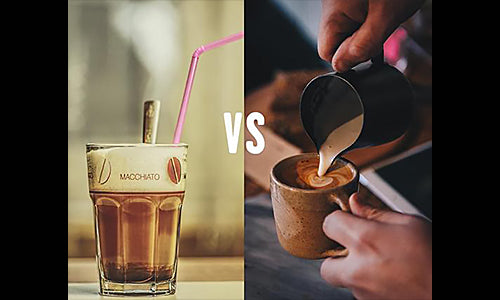Your Cart is Empty

Macchiato VS cappuccinois not much of a debate, but you’re likely to get confused if you come across the two in the menu of your local coffee shop. This is because it seems more and more modern baristas are keen to make their mark on the scene. They can’t stop adding new options to the blackboard every week.
Or isn’t this the case?
Whichever it is, the purpose of this article is to help you avoid a guilty look when you visit the new café that’s opened down the street and find new names on the menu.
Loosely translates to “spotted” in Italian, the Macchiato is commonly called the Caffe Macchiato or an Espresso Macchiato by those who’d like to showcase their coffee lingo. So, whenever you find one of these on the blackboard menu, you know it’s still the Macchiato. If the café you’ve entered is Portuguese, then expect to see “Café Pingado” or “Coffee With A Drop.” Don’t let them confuse you.
The Espresso Macchiato is one of the few coffees with a considerably bolder flavor than most other coffee options on the list. It is a layered coffee cup of milk and espresso. Every barista has his take of how the Café Pingado is made, but an unshakeable rule is that it has to have double espresso shots at the bottom, steamed milk in the middle, and then a milk foam layer.
Now, ratio isn’t really considered in Macchiato. So except if the café is asking you for your preferred ratio or you’re making this at home, there isn’t any need to bother as long as it contains milk and espresso.
Needless to say,high-quality beans are a must for the best Café Macchiato.
Interestingly, Cappuccino is very much similar to the Macchiato, despite that it originates from the Austrian Kapuziner. However, this is a more organized option than the Macchiato, so if you’re a sucker for balance, this is it. Cappuccino is made with equal parts of espresso (1/3), steamed milk (1/3), and milk foam (1/3).
Espresso makes the basis for Cappuccino, before pouring hot steamed milk with care and deliberateness from a metal jug. You have to see that only the milk leaves the jug — you don’t want the foam to get. After this, use a spoon to add the milk foam in the Cappuccino.
Occasionally, some baristas may prefer to add a light cinnamon layering of rich chocolate powder on the foam again, making four layers. Cappuccinos are similar to Lattes in this regard (elaborate topping designs), but this isn’t an everyday practice.
The Cappuccino is ideal for coffee lovers who enjoy the bold flavor of the espresso but think it’s a bit extreme at the bitter end. This three-layered drink takes out bitterness, naturally leaving a delicious flavor in your mouth.
Choosing a side in theMacchiato Vs. Cappuccinodebate is straightforward yet tricky. There’s often a difference in taste due to the different ratios of components, so which do you prefer? Not every café wants to spend time using ratios for espresso, milk, and foam. You are likely to find the Macchiato more commonly.